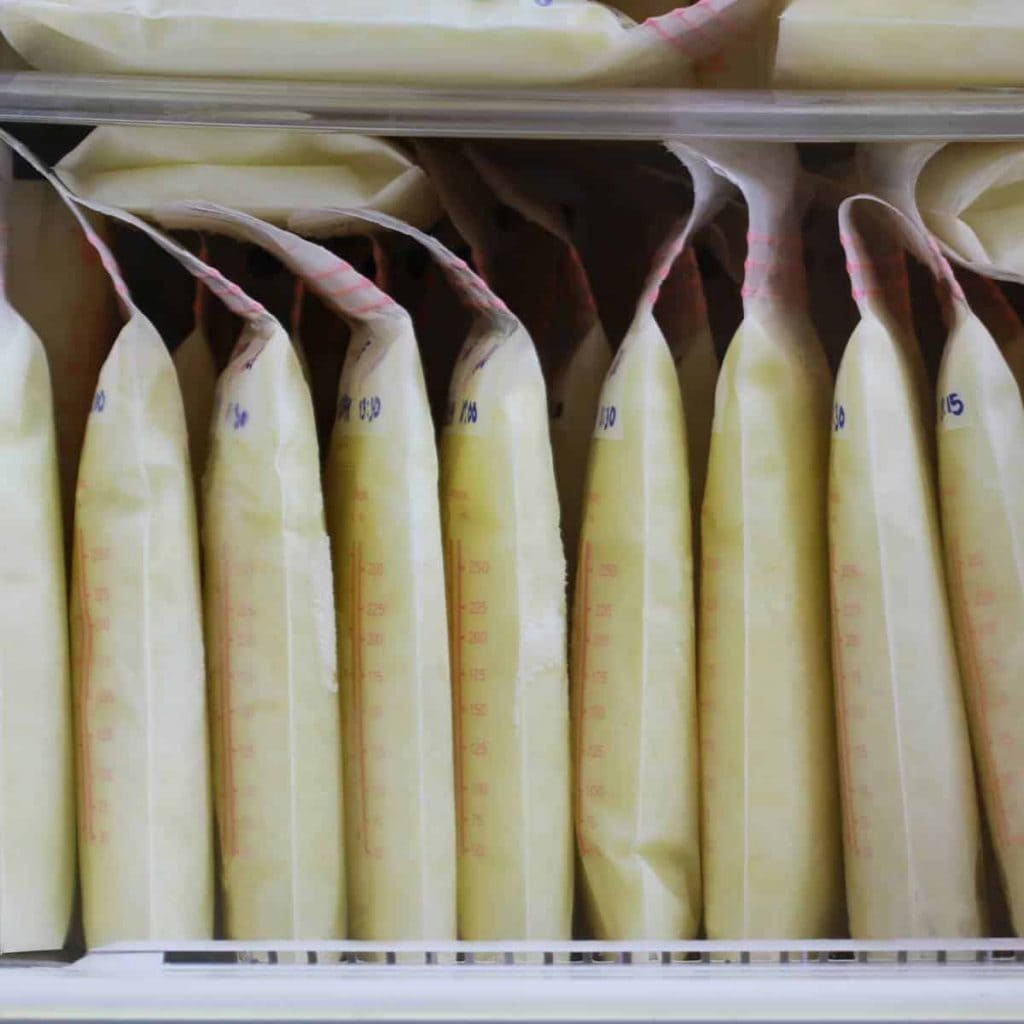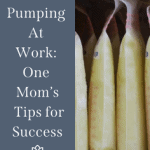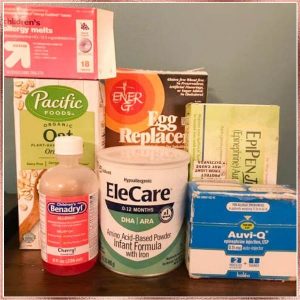Pumping at work poses its own unique challenges for new mothers, and it often comes at a time of difficult transitions for both mom and baby. You may feel like you’ve only just started to get to know your little one when it’s time to head back to the grind.
There’s no getting around the feelings of mom guilt and loss from returning to work, but you can make your first week back a little easier by having a solid plan for pumping.
In this article, we’ll cover all the basics of pumping at work, as well as offer some practical advice from my own experience as a working breastfeeding mother.

This site contains affiliate links, meaning that we earn a small commission for purchases made through our site. We only recommend products we personally use, love, or have thoroughly vetted.
- Preparing for Pumping at Work: Pumping on Maternity Leave
- Improve Pumping at Work With The Right Breast Pump
- Working With Your Employer and Understanding Your Rights While Pumping At Work
- Safe Cleaning and Storage Tips After Pumping At Work
- Establish a Pumping At Work Schedule
- Getting Comfy While Pumping at Work
- Find Your Pumping At Work Community
Preparing for Pumping at Work: Pumping on Maternity Leave
In your semi-conscious, spit-up covered state, exchanging fifteen precious minutes of freedom for a pumping session is a hard ask. I’ve been there, and it sucked.
Two things got me through those extra pumps: Stranger Things and lots of hot fenugreek tea. And if you don’t know about fenugreek tea; it’s a galactagogue, or substance that can help with milk supply. It’s an acquired taste, but I loved it!
Many of those pump sessions were about building my supply, but eventually, I started storing milk so I could actually leave the house alone.
Building Your Milk Stash
As someone who could only pump a modest amount of milk, I was always just 4-5 servings of milk ahead of what my baby needed for daycare.
I also spent 3 hours of my workday pumping, cleaning, and storing my precious 10-12 ounces.
It was incredibly stressful at the time, and upon reflection, I wish I had put in consistent effort to gradually and safely build a freezer stash of milk.
I say “safely” because you’ll want to be careful not to create a breast milk oversupply. Painful, engorged boobs? No, thank you!

Rule of Thumb for Pumping Extra Milk
Experts like Nancy Mohrbacher, IBCLC (aka board-certified lactation consultant) suggest pumping 30-60 minutes following the first morning feed when your supply is normally higher for breastfeeding mothers.
If you’re pumping only 1-2 ounces or about half a feeding, don’t worry! That’s typical especially in the first three months.
Before my supply regulated, I found that a passive pump like the Hakaa was perfect for collecting a couple ounces a day in addition to my electric pump sessions.
Keep in mind that you may be able to produce much more than this if you are already exclusively pumping.
If you are having any concerns about your milk supply or think you might be experiencing an oversupply, it’s important to meet with a IBCLC before adding pumping into a daily routine.
Improve Pumping at Work With The Right Breast Pump
Choosing a breast pump can feel a bit like life or death when you know you’ll be relying on it to help feed your baby.
The good news is there are so many varieties of breast pumps on the market, you are sure to find one that fits your needs!
One of the most popular breast pumps for working mothers is the Spectra S2 Electric Breast Pump as it travels easily and offers hospital-grade suction.
I found that the Spectra S2 actually worked better for me than the $1500 hospital grade pump provided by my place of work. (Want to go cord free? The Spectra S1 is rechargeable!)
Using the right parts can also help cut down on your workload once you get home. If you pump straight into a bottle and then transfer your milk to a storage bag, you’re adding to the parts you have to sanitize, even though this is how most pumps were created. But we love the major time-saving solution Kiinde created.
Kiinde’s genius direct pump feeding system allows you to pump directly into storage bags, and then to feed your child straight from a bottle using those same bags. It saves pumping mamas hours on dishes!
Things To Consider When Selecting A Pump for Pumping At Work
Some characteristics to look for in a breast pump for work include:
- Portability. If you plan to pump at home on the weekends, you’ll need something that is easy to transport. Consider purchasing a car adapter.
I pumped in the car many times before off-site meetings, after a late yoga class, or even when my husband and I were on a date. Sexy!
- Noise. Quieter pumps are great if your pumping area is not very discreet, or if you simply want to watch videos or listen to music.
- Comfort. Pumps have their own style and size of plastic cups that fit over the breast to collect expressed milk (known as a flange.) This helpful video covers general tips for finding the right flange style and size, but consult an IBCLC for additional support.
Working With Your Employer and Understanding Your Rights While Pumping At Work
Legal protection for pumping mothers comes from the The Fair Labor Standards Act of 1938 and it includes:
- a reasonable break time for an employee to express breast milk for her nursing child for 1 year after the child’s birth each time such employee has need to express the milk; and
- a place, other than a bathroom, that is shielded from view and free from intrusion from coworkers and the public, which may be used by an employee to express breast milk.
For hourly working mothers, keep in mind that you may need to clock out for each pumping session depending on whether or not you can continue to work while pumping.
Each state also has their own individual laws around breastfeeding, which may provide additional protections.
Where Can I Pump At Work?
As a public health professional, I was fortunate to have an entire lactation room with private and comfortable seating, a sink, and a milk-only refrigerator. It was awesome!
With lots of wiggle room in the law, your pumping space may be an empty office, a storage room, your cubicle, or some other space that is less than ideal for privacy.
If your pumping area at work is making you uncomfortable or isn’t suitable for pumping, speak up early and don’t be afraid to approach your employer with some ideas for how to improve.
Having a lactation program is actually good business. Supporting breastfeeding in working women reduces absenteeism when caring for a sick child and promotes employee retention.
What’s not to love about this from an employer standpoint?
Safe Cleaning and Storage Tips After Pumping At Work
When transporting your baby’s food back and forth from work every day, developing a good food safety routine is vital.
Freshly pumped breast milk can remain at room temperature for up to 4 hours, and it can remain refrigerated at 40 degrees Fahrenheit for up to 4 days.
Always use clean hands when pumping and make sure your pumped breast milk is properly sealed in a milk storage bag or bottle.
How Often Do I Need To Clean And Sanitize My Pump?
All pump parts that come in contact with breast milk should be washed in warm soapy water and allowed to air dry every day.
As a former health inspector, one mistake I see a lot of mothers making is allowing their pump parts to dry in the splash zone of their sink.
Bacteria can make their way onto the pump parts when contaminated water splashes up and out of the sink while hand washing, prepping meats or veggies, or washing dishes.
Yuck! Keep your drying parts far away from the busiest areas of your kitchen like the sink.
Daily sanitization either by using boiling water, by steam bag in a microwave, or by running the parts through a dishwasher with a hot drying cycle is typically only necessary in the newborn phase or if your child is immune-compromised.
There’s no need to wash pump parts between uses at work. Simply gather the pump parts and store them in the fridge along with your pumped milk until the next use.
Can I Store My Milk In The Community Refrigerator At Work?
Breast milk is considered a food item, not a biohazardous material, so it can be stored in a work refrigerator with other foods.
If your employer has issues with breast milk in the community fridge, request a small refrigerator for storing your milk safely during the day.
To avoid having your milk contaminated by your coworkers accidentally, many women will store their milk in a small, sealed cooler or bag that is placed directly into the fridge.
A thermal lunchbox is perfect for this!
When using a community fridge, it’s important to always label your milk with your name to avoid mix-ups with other pumping coworkers.

Establish a Pumping At Work Schedule
While you will eventually develop your own unique schedule, it’s generally recommended to pump about every 2-3 hours that you are away from your baby.
Pumping sessions should last for 15-20 minutes.
My pumping schedule included 8:30am, 11:30am, and 2:30pm pumping sessions as well as a pump about 30 minutes after baby’s bedtime. If I wasn’t busy, sometimes I’d squeeze in one more!
Blocking your pumping sessions on your work calendar can keep you on track and help your coworkers know when you might be unavailable.
How Do I Combine Breastfeeding And Pumping At Work?
The key to combining breastfeeding with pumping is to continue to offer your baby the breast frequently at home.
Babies are much more efficient than pumps at removing milk, and most of their nutritional needs will be met during your non-working hours.
To protect your supply and to ensure your baby is getting enough milk, you’ll want to nurse as soon as you’re reunited with your baby each day and then as your baby desires during the morning and at night.
Your baby may be more interested in nursing during the nighttime once you return to work, and they may wake more frequently to get those extra calories/missed mommy snuggles.
The lack of sleep can take a toll on your well-being. Finding ways to relax and let off steam are more important than ever.
Offering lots of one-on-one cuddle time during the day (hello, newborn babywearing!), sneaking in a yoga class or long walk, and getting to bed early helped me through this difficult but temporary season.

How Much Do I Need To Pump For Daycare?
Infants exclusively consuming breast milk under 6 months of age will need about 1 ounce of breastmilk for every hour they are separated from Mom.
If you’re away from your babe for 10 hours, you’ll need about 10 ounces separated out into 2-3 ounce feedings.
It’s important to be aware that formula fed babies require substantially more milk by volume.
About 80% of the babies in my child’s classroom were on formula at school, and it made me nervous seeing these massive bottles of milk in the school fridge.
In addition, my child’s bottle-happy caregivers were quick to give my son milk whenever he was upset. I constantly had to remind them that being fussy did not mean he was hungry.
It made me second guess myself. Am I sending enough? Am I doing this right?
The wonderful thing about breastmilk is its composition changes as the baby grows.
Imagine having the perfect food tailored precisely to your specific needs at every stage of your life. You wouldn’t need to eat a lot if your food was densely packed with all the nutrients you required!
Getting Comfy While Pumping at Work
If you don’t take anything else from this article, please remember this: You’ve got to find small ways to take care of yourself.
You probably can’t take a weekend trip to Tulum with your girlfriends right now. You’ll enjoy that type of self-care again one day, but for now, keep it short and simple.
Here are a few easy ways to add some comfort into your pumping sessions:
- Give your arms a rest with a hands-free pumping bra.
- Grab your softest, coziest sweater and only wear it while pumping
- Make a thermos of warm, herbal tea
- Listen to a 20-minute podcast
- Watch some Netflix on your phone.
- Use a calming essential oil roller on your face and chest
Find Your Pumping At Work Community
Studies show mothers with adequate support are more likely to breastfeed for extended periods than mothers on their own. It’s time to find your people!
Work With a Board-Certified Lactation Consultant
Many women consult a IBCLC early on in their breastfeeding journey, but lactation consultants are also available to provide advice for women at each stage of their pumping journey, too.
Sometimes you just need to hear from a professional that what you’re experiencing is perfectly normal. And sometimes you might truly need expert assistance.
Either way, don’t be afraid to reconnect with your lactation consultant before heading back to work.
Join Local Breastfeeding and Pumping Groups
When my son was about a month old, I attended a La Leche League meeting at a local church.
Despite the stress of going out into public with a newborn, I felt suddenly at home as I walked in the door. Being surrounded by other breastfeeding mothers gave me confidence I was doing the right thing.
There are a variety of mom groups and organizations both in-person and online that can give you that same warm, cozy feeling while speaking to your individual experience and preferences.
The best way to find these groups is simply to ask mothers you know who are going through the same challenges or who share the same values.
While there aren’t as many groups for exclusive pumping mothers, they do exist.
Large online groups like the Kellymom Breastfeeding Support group or the Exclusively Pumping Moms group are great places to start.
We’ve covered the basics of pumping at work, but there’s still plenty more you’ll learn about yourself and your pumping routine in the days and weeks to come.
One day you’ll be a bad mother pumper, and perhaps you can come back to share your knowledge.
The Undefining Motherhood community is here to support you through these challenging times and to provide encouragement for whatever choices you make for you and your baby.
Are you a veteran of pumping at work with wisdom to share? Or perhaps you’ve got some surprise pumping hacks for other working mothers? Spill the milk on your pumping secrets.










